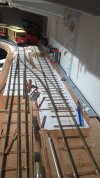DafyddElvy
1:22.5 & 15mm Scale Trams, , NG Steam Railways
I have recently encountered the problems of modelling track with non fine scale wheels needing to pass over my fine scale point work. To accommodate the less than fine scale wheels I have retained the check rail flange way and slightly increased the crossing nose flangeway, what I have also tried to do is, where the wheel flange width permits, is increase the back to back measurement to 41mm, if doing this one also needs to be aware of the back edge to running edge distance and ensure the over flange gauge of the wheels does not exceed to track gauge, I hope this all makes sense.

